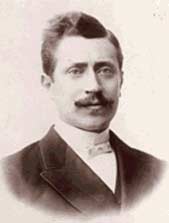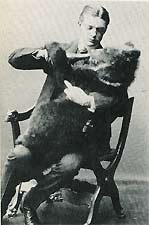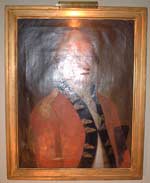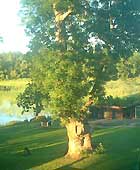









Legends and LoreWe shortly want to tell you about some of the funny and strange events that have occurred at Rockelstad These histories have mainly come to our knowledge through word of mouth from local people and precedent generations.Heidenstam and the Ghost of Charles XII
Among other things the royal ghost wore yellow moose-skin gloves. This was puzzling, for the historians believed that the King used white gloves. Now, this may appear a minor issue, but the patriotic Swedish people at that time shared a passion for their Hero-King, that even included his gloves. Heidenstam chooses to believe the ghost anyway, and wrote in his book that the King wore yellow gloves. The expected reaction from the academics did not wait, and his unhistorical writing was criticized. But he was eventually proven right, when the tomb of King Charles XII was opened some years later, and all could see that the ghost at Rockelstad had been right; the gloves were indeed yellow. This story Heidenstam later published in a collection of short-stories. Mischa the Bear and Rudolf Abelin
The Wine TreasureSomewhere in the Park surrounding Rockelstad is a treasure of wine buried. Carl Sylvan had made a substantial fortune during the good times, and in 1889 had the towers built on the castle. The position at the Court no doubt provided good business opportunities, and probably contributed in filling his well supplied wine-cellar. When Sylvan later went bankrupt, the wine was still there, and rather than leaving it to his claimants he decided to bury it in secret.Carl Sylvan fled to New York where he started from the bottom and worked himself up to be a successful hotel owner in Chicago. He supposedly met the man who during von Rosen’s ownership was farming the estate in New York in 1912, who was among the survivors of Titanic. But exactly where the wine was dug down remains a mystery. The Ghost-ladies StuartDavid Stuart, who in 1642 had built the mansion that is preserved in the centre-section of the castle, was married twice. His first wife was Anna Kruse of Alghammar and his second was Brita Liljeram of Langbro. Those two wives are the traditional ghosts of Rockelstad, and many have been seen them through the centuries. They are dressed in long black robes and lace collars.According to legend the Ladies never met in life, why they have a lot to discuss, especially since they had been married to the same husband. Typically they are seen gliding silently across the yard, arm in arm and whispering, or sit in a niche in the upper floor of the west wing, where they are seen as shadows against the twilight. The Stuart Ladies are, however, harmless ghosts who usually keep to themselves, and if they notice that someone sees them, they just vanish. Most common is that visitors hear them moving around on the upper floor of the west wing. Often the guests ask in the morning if someone has been on the upper floor, when it is certain that it was empty. But perhaps there are other supernatural beings in the wing than the Ladies, for lately several visitors have seen the ghost of a young girl and other unexplainable things. The Screaming DrumDuring his hazardous adventures in Africa Eric von Rosen came across many artefacts from the various tribes he encountered. Many of strange items ended up at Rockelstad, where the upper floor of the Great Hall was served as an ethnographical museum. Some of these objects were terrifying, ghastly masks, skulls and the like. The Magical Drum came from a tribe of pygmies in Central Africa. It consisted of a small drum on a stick, with two balls attached to strings that beat against the drum when it was rotated. These balls were made of shrunken and stuffed human heads, complete with hair and everything.The heads were from a loving couple from warring tribes, who had died for their love! This drum was used by the shaman of the tribe to call upon the spirits of the forefathers. Naturally such a magic object could not find peace nailed to a wall in Sweden. Subsequently the drum made a horrible screaming sound at night, which terrified many visitors. The drum is now kept in the ethnographical museum in Stockholm, where it reportedly continues to scream out its agony. Ristell and the Royal Moose
And the animals became much loved companions, who were buried on a particular moose-cemetery at Vangsjoberg. But the shot at the opera didn’t only kill the King, also the moose and Ristell were discarded. The moose stud-farm was abandoned and Ristell was imprisoned for life. And the only thing reminding of this funny episode is the named and dated gravestones on the now derelict moose cemetery. Yggdrasil the Magical Ash Tree
This way the tree became magical, and the same night that Eric von Rosen diseased a lightning struck and split the tree, and two of the canopies fell down. When years later the Countess passed away, a storm came that once again halved the tree, and one single canopy remained. But the age old ash is still vital, and now two new canopies are growing up. |
|














 På Svenska tack
På Svenska tack